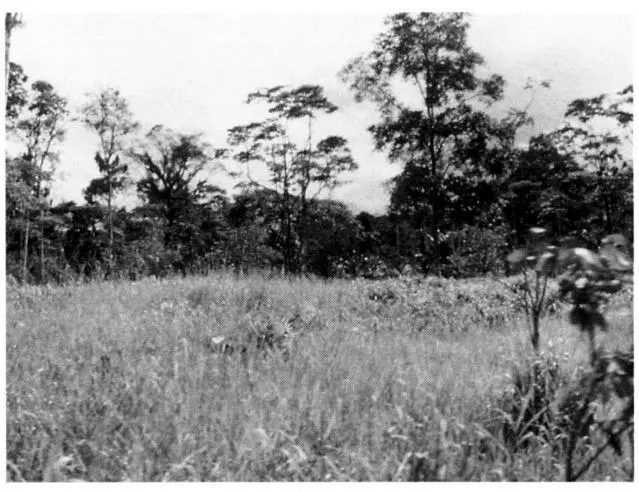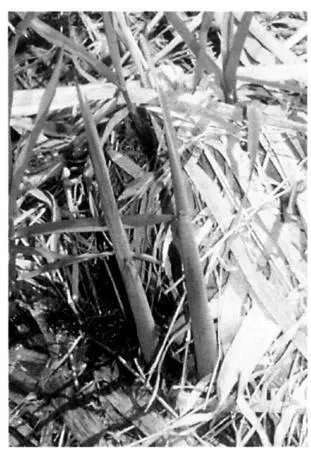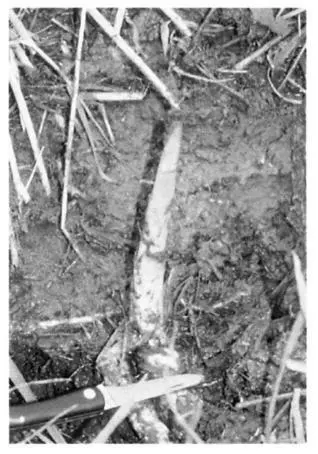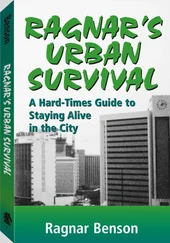Ragnar Benson - Ragnar's Urban Survival - A Hard-Times Guide to Staying Alive in the City
Здесь есть возможность читать онлайн «Ragnar Benson - Ragnar's Urban Survival - A Hard-Times Guide to Staying Alive in the City» весь текст электронной книги совершенно бесплатно (целиком полную версию без сокращений). В некоторых случаях можно слушать аудио, скачать через торрент в формате fb2 и присутствует краткое содержание. Год выпуска: 2009, ISBN: 2009, Жанр: Старинная литература, на английском языке. Описание произведения, (предисловие) а так же отзывы посетителей доступны на портале библиотеки ЛибКат.
- Название:Ragnar's Urban Survival: A Hard-Times Guide to Staying Alive in the City
- Автор:
- Жанр:
- Год:2009
- ISBN:1581600593
- Рейтинг книги:5 / 5. Голосов: 1
-
Избранное:Добавить в избранное
- Отзывы:
-
Ваша оценка:
- 100
- 1
- 2
- 3
- 4
- 5
Ragnar's Urban Survival: A Hard-Times Guide to Staying Alive in the City: краткое содержание, описание и аннотация
Предлагаем к чтению аннотацию, описание, краткое содержание или предисловие (зависит от того, что написал сам автор книги «Ragnar's Urban Survival: A Hard-Times Guide to Staying Alive in the City»). Если вы не нашли необходимую информацию о книге — напишите в комментариях, мы постараемся отыскать её.
Ragnar's Urban Survival: A Hard-Times Guide to Staying Alive in the City — читать онлайн бесплатно полную книгу (весь текст) целиком
Ниже представлен текст книги, разбитый по страницам. Система сохранения места последней прочитанной страницы, позволяет с удобством читать онлайн бесплатно книгу «Ragnar's Urban Survival: A Hard-Times Guide to Staying Alive in the City», без необходимости каждый раз заново искать на чём Вы остановились. Поставьте закладку, и сможете в любой момент перейти на страницу, на которой закончили чтение.
Интервал:
Закладка:
Snaring rats with very light cable is practical, but you gotta be very hungry. Make snares out of six or eight hair-thin wires pulled from an appliance cord. Loops are set about 1 1/2 inches in diameter in rat runs. Set out eight or 10 snares at a time. After sufficient rats are caught, pull the snares for a week.
Ductile copper acts as its own irreversible slipknot. Hung up, rats quickly strangle themselves, explaining why the traps should be set out in large numbers and checked frequently, and why this is such a disgusting procedure. Even 1 question regularly eating strangled rat
BIRDS
There are a few edible birds in cities. Especially cities with older buildings, damaged and opened so that roosts are convenient. There are pigeons, seagulls, starlings, and even an occasional robin or thrush. Birds are good food for survivors when they can be caught without great effort. Birds fly out to get their own food and water without outside help or direction. The been there, done that folks tell me my large flight traps as described in Survival Poaching and Live Off the Land in the City and Country are impractical for real hard-core city survival. Too big, obvious, tough to build, and too tough to move, they say.
One effective method, previously mentioned for ducks and geese, is to bait very small fishhooks tied to light fishing line with single kernels of corn, a pea, or grain of wheat. Fishhooks can be set unobtrusively in large numbers on building tops in parks or wherever birds feed and where hooking them will not attract attention.
African bird snares are a practical, efficient alternative to larger, cumbersome, obvious bird traps. African bird snares perform nicely on all birds from sparrow size up through turkeys. Snare sizes must be adjusted, but realistically there are only three: small for robins; intermediate for pheasants, grouse, and ducks; and larger sizes for turkeys and geese.
These snare assemblies are made from cross-strips of flat wood. Simple laths., pickets, or even paint can stirrers will work for little snare assemblies. Two-by-four limbs or pieces of wood make a good basis for goose and turkey snares.
Small, hair-thin wires are pulled from copper-wire appliance cord for the snares themselves. Each device has four snares, one on each arm of the wooden cross. Use five or six strands of wire for little birds and 10 or 12 strands on larger critters.
Bait is placed in the middle of the cross. Birds that come in to eat quickly get their legs or necks caught in the snare. Loss of the device is sometimes a problem. Even very small birds can pull the snare assembly out of sight in rough, rubbly areas.
Other, much more complex bird-catching devices are out there, but hooks and African bird snares will virtually always do the job without a great deal of stumbling around.

Cattails growing in the upper Amazon Valley in eastern Ecuador. Cattail plants grow everywhere.
CATTAILS
Absolutely every city in the world I know of has cattails growing someplace within its boundaries. I have observed them from Barrow, Alaska, to Washington, D.C., to Quito, Ecuador.
Cattails were real manna for our Indians. They specifically camped near large cattail beds so they could feed off the plants. Cattails are always nutritious and healthy, even when grown in heavily polluted waters. There's no question about their identity. They are the ones with brown, tufty, wiener-like flowers at the end of a long stem that we used to dip in diesel and burn for torches when we were kids. It is impossible to mistake these guys for something else.
Cattails as a source of food have so many ways of treating you, you are bound to like one of them. Starting at first blush of spring, shoots grow up from the main roots that eventually become this year's stem and leaves. These fresh, new little shoots are good eat ing. Dig and cut up these shoots when they are about 4 to 10 inches long. After 10 inches, the shoots start getting stringy and tough, with a kind of bitter taste, but they still can be harvested, steamcooked, and eaten up until the plants are about 18 inches tall.

Springtime brings new cattail shoots, which are good eating.

Cattail roots can be dug in fall and winter. With a rabbit or muskrat thrown in the pot, whole families have survived the winter on boiled cattail.

When fresh food is at a premium, cattails offer an easy-to-find solution.
Cut the young shoots into macaroni-sized chunks. Boil or steam. They are best with salt and butter, but these seasonings probably won't be available in survival circumstances. Reportedly they are nutritious. These shoots can also be canned, frozen, or pickled, much like asparagus. When the main season is on, production from just a small patch can be surprisingly large.
Next comes a harvest from the flowers. These are the dry, brown wiener-shaped tops that all of us have seen in cattail patches. Before maturing, these flowers are green, tender, and good, much like ears of corn. Pack them as early as possible. Steam in a flat, covered pan for abort 15 minutes.
Shortly after the flowers mature, they pollinate. We often see clouds of yellow dust flying about bodies of water without knowing the pollen is from the cattails. This pollen ranges from edible to quite good. Collect it by placing a thin plastic bag over the flower and shaking vigorously Usually a teaspoon of pollen will be harvested per plant.
Use this pollen half-and-half with wheat flour or use it straight just like flour. The resulting biscuits are heavy, filling, and hard. Some people say they may even be as nutritious as biscuits made with flour Realistically, I have no way of measuring this nutrition.
Cattail roots actually fatten up in anticipation of winter's lean times. During fall and winter these roots are dug up, cleaned, and cut up to be boiled and eaten. Eat the whole porridge-like mess or filter and dry the starch from the fiber as a kind of super-bland mashed-potato mix. Entire families have lived through winters on these roots with only addition of a small rabbit, a rat or-in some cases-a muskrat to the pot. Don't mistake this for good, but it is life-sustaining. All survival food is monotonous.
Exercise care with winter harvest of cattails. The bed will be slowly killed by removal of the roots.
CITY GARDENS
There are common edible items that city survivor hunter/gatherers can expect to find and use to augment their food supplies in or near built-up areas. All will definitely not be available all of the time. When available, all are relatively quick and easy, nicely meeting survival-thermodynamics criteria. Cattails are the exception, in that they are always available in some form or another. In spite of my best efforts to call attention to their value as emergency food, few survivors seem to know or care about cattails.
Gardens are possible even in the most intense inner city situations. Even in the heart of the asphalt jungle, gardens can be eked out of vacant lots, along boulevards, in grassy median strips along superhighways, and in highway cloverleaf structures. I have even seen nice rooftop gardens in downtown Rome and Chicago. These gardens raised ornamental plants, but could easily have contained something as practical as beans, zucchini, carrots, and potatoes.
Читать дальшеИнтервал:
Закладка:
Похожие книги на «Ragnar's Urban Survival: A Hard-Times Guide to Staying Alive in the City»
Представляем Вашему вниманию похожие книги на «Ragnar's Urban Survival: A Hard-Times Guide to Staying Alive in the City» списком для выбора. Мы отобрали схожую по названию и смыслу литературу в надежде предоставить читателям больше вариантов отыскать новые, интересные, ещё непрочитанные произведения.
Обсуждение, отзывы о книге «Ragnar's Urban Survival: A Hard-Times Guide to Staying Alive in the City» и просто собственные мнения читателей. Оставьте ваши комментарии, напишите, что Вы думаете о произведении, его смысле или главных героях. Укажите что конкретно понравилось, а что нет, и почему Вы так считаете.











